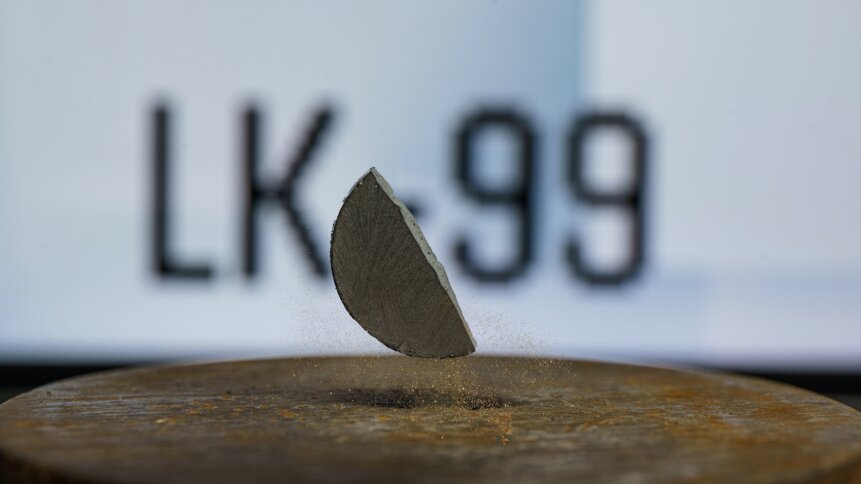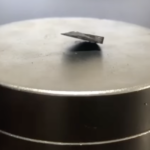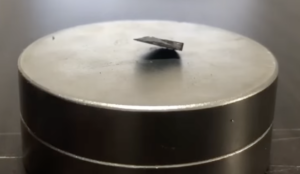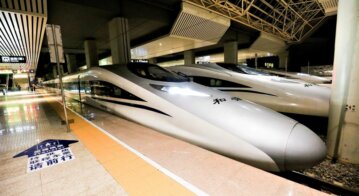
- LK-99 is likely not a room-temperature superconductor.
- Replication attempts have not produced sufficient results.
- Scientists claim levitation could be from diamagnetism.
The verdict is in: LK-99 is not the beginning of a new era of electronics.
Hopes for the potential room-temperature superconductor were dashed by a scathing summary from the University of Maryland’s Condensed Matter Theory Center last week on X, formerly Twitter.
“With a great deal of sadness, we now believe that the game is over,” the tweet read.
“LK99 is NOT a superconductor, not even at room temperatures (or at very low temperatures). It is a very highly resistive poor quality material. Period. No point in fighting with the truth. Data have spoken.”
The experts drew their conclusion from the results of a growing body of replication attempts that have taken place at institutions around the world. As soon as the two original papers which debuted LK-99 were published and made the inflated claim that the result “opens a new era for humankind”, academics and amateur scientists were hot on their tracks trying to recreate it.
This enthusiasm, both from the original South Korean authors and the wider scientific community, stems from the fact that a room-temperature superconductor would revolutionize technology as we know it.
YOU MIGHT LIKE

Tech revolution from superconductors on horizon?
A superconductor is a material with zero electrical resistance, so it can conduct electricity with 100 percent efficiency. These do already exist, however, they only exhibit this property when cooled to extremely low temperatures or under extremely high pressures. This makes them very expensive to use practically for, say, wires in electricity grids which do not lose any of the electrical energy they carry as heat.
But if superconductors could be formed at room temperature, or close to it, they could be used in ultrafast and energy-efficient computer chips and servers. They would also lower the price of quantum computers, making them more widely available to solve complex problems for researchers.
LK-99 fits the bill, kind of. The researchers claimed it had zero resistance at temperatures of up to 400 K (127 °C, 260 °F) at ambient pressure. They also published a video showing it partially levitating, which they claimed was evidence of the Meissner effect, another hallmark of superconductivity.
This is when a superconductor ‘levitates’ after being placed on top of a magnet because it expels a magnetic field from its interior. The researchers added that it was not completely levitating in their video because it is an impure sample.

‘Levitating’ room-temperature semiconductor. Source: Lee S et al. (2023)
However, scientists had a problem with many of their claims. The synthesis of LK-99 involved mixing several compounds containing lead, copper, oxygen, sulfur, and phosphorus and heating them to very high temperatures, but the chemical equations provided to illustrate what was happening were not balanced. The synthetic instructions were also strangely vague, not including details like cooling rates for the furnaces.
The compound created was, as admitted by the Korean scientists themselves, not a pure sample, which negated the measurement of zero resistance. The levitation could also have been through magnetic repulsion unrelated to superconductivity.
Other common tests that confirm superconductivity were not included, and the researchers did not analyze the sample in the traditional manner which would verify its exact structure.
Finally, the accompanying video doesn’t actually show the material fully levitating – only one side rises off the magnet. This led researchers to believe that the observed Meissner effect stemmed from impurities creating areas of superconductivity rather than the compound as a whole.
The two papers themselves were submitted in an unconventional manner, with a few hours between them and attributions to different authors. Some of the researchers involved later admitted that one of the papers was incomplete and contained “many defects”.
However, there was only one way for the skeptics to be totally sure that LK-99 was a fraud – to make it themselves.
The Beihang University in Beijing quickly ruled the material as not being superconductive after their reproduced sample gave a high measurement for resistivity at room temperature and did not repel or levitate over a magnet.
This was not the case for another fragment of reproduced LK-99 from the Huazhong University of Science and Technology in China, whose video showed a fragment floating at multiple angles. This is evidence of ‘perfect diamagnetism’, an indicator of superconductivity.
First claimed successful replication of LK-99
Accomplished by a team at the Huazhong University of Science and Technology and posted 30 minutes ago.
Why this is evidence:
The LK-99 flake slightly levitates for both orientations of the magnetic field, meaning it is not simply a… pic.twitter.com/bh0x9oqaz2— Andrew Côté (@Andercot) August 1, 2023
However, as author Chang Haixin told TIME, it is difficult to distinguish perfect diamagnetism from strong diamagnetism, and the latter is demonstrated in materials that are not superconducting. The National Taiwan University and the National Physical Laboratory of India also reported diamagnetism in their respective samples, but these did not show zero resistance or any other indication of superconductivity.
The International Center for Quantum Materials in China observed signs of ferromagnetism – where it can become magnetized by a magnetic field – in flakes of reproduced LK-99, but, again, this was ruled as not being indicative of a room-temperature superconductor.
In the fortnight since the first papers were released, and gained widespread attention through a post on Hacker News, reports from the US, Russia, Spain, and the UK have also concluded that LK-99 is not the Holy Grail material and confirmed its structure.
Andrew McCalip, an engineer at space start-up Varda Space Industries, live-streamed his ‘backyard’ replication attempt on Twitch and live-tweeted it on X. Only a few of his fragments responded to a magnetic field, and he also detected impurities that could explain the observed phenomenon.
Meissner effect or bust: Day 8.5
We made the rocks pic.twitter.com/ygVOATBaHD
— Andrew McCalip (@andrewmccalip) August 4, 2023
Other labs have provided theoretical explanations for what the South Korean team observed in their sample. Still, these do not prove that the cause is superconductivity beyond a shadow of a doubt. There have been no complete successes so far in replicated experiments.
Last week, the Korean Society of Superconductivity and Cryogenics, which set up an investigative committee at the start of August to verify the results of the original papers, told Bloomberg that it is still awaiting the original samples of LK-99 for independent assessment.
While this final result is still weeks away, the consensus is clear, albeit disappointing. Data have indeed spoken.





